Badan or camneur is a long-term grassy plant from the SaxiFragace family. Today, this culture is made to allocate in a separate genus Bergenia, but because of confusion it was not always. Badan is found mainly in the moderate climate of the northern hemisphere. The main territory on which culture grows is Asia. In particular, Badan can be found in the Altai Territory, Siberia, Primorye and Kazakhstan. In addition, it grows in the territory of such eastern states as Mongolia and Korea.
Content
Culture characteristics
It is worth noting that Badan is capable of growing in various conditions. In nature, he is well caring in coniferous and deciduous forests, forest-steppe zones, mountain meadows and forest areas close to the mountains.
The plant belongs to the class of dwoom. At the same time, he has appropriate signs:
- In particular, two cotyledons are located in the seed of the plant.
- Badan has rhizome in the form of a rod, which closely lies with the surface.
- Plant leaflets located on the stiff are decorated with small veins located in the form of a grid.
- Like all terrestrial plants on the bottom of the sheet, there are pores intended for gas exchange.
- Flowers with a special type of symmetry have five partially contrived petals.
- Large leaflets form a root rosette and in shape resemble an elephant ears.
- Petals form a cup of purple, pink, reddish or white.
- In addition, like all the dysfolic plants, Badan has a double perianth.
Organic substances accumulate thanks to the thickened rhizomet. This must be taken into account when planting this plant. Badan bloom usually begins in the spring, in some cases it can continue until the beginning of summer. Thanks to the early blossom, the plant has no problems with insect pollinators who easily notice the flower on a high bloomer. Fruits Culture brings only by the end of summer. The fruit has a view of a box, which contains a large number of small badan seeds. Growing and care for this plant is described below.
Badan: landing and reproduction
The best time for reproduction is the period after the end of flowering. This usually falls on the autumn. Due to the fact that the rhizer is close to the surface of the earth, it can be easily digped. So that the root system is not damaged, the earthen shaft must be disappeared. Before disembarking, seedlings must be sterilized. This can be done with a chlorine bleach or a weak mortar solution. For example, to prepare such a mixture it is necessary for one part of potassium permanganate to dilute in ten parts of water. After that, the seedlings are transplanted into small pits. With a large number of sprouts, you can unscrew the wells in the form of a trench.
This plant can multiply by two main ways:
- generative
- vegetative.
The second method is considered the fastest and simple. In this case, the culture is multiplied by the division of the bush, i.e. Through vegetative organs. To get the best results for disembarking, it is recommended to take young rhizomes. After all, they contain more vegetable tissue. The reproduction of this way should not be a problem, if only because new roots are close enough in the soil. Therefore, they are easy to dig without damage to the main root.
The reproduction of this method is made in late spring or early summer. For successful division at each individual root must be at least 4 root kidneys and a pair of leaves. For separated parts, a depression of 11 cm is prepared in advance. And there should be a distance of at least 35 cm between neighboring pits between the adjacent pits. After landing, the Earth needs to be poured. Such a division is advisable to hold no more than once every 4 years.
The generative reproduction implies the cultivation of Badan from seeds. We already know that in the fruits of this plant contains quite a lot of seedlings. First, it is better to plant them in some container, and after that in the soil. Thanks to this, sprouts will be able to become much stronger. In addition, young plants will die so less. When seedlings grow to 110-130 mm, they can be planted in an open ground. This method of reproduction has one significant drawback, namely, too long the period of cultivation. At the same time, problems with the germination of some seeds may arise. In order for the shoots more, the landing material is recommended to be placed in a weak solution of fungicide. This will allow Badan from seeds to germinate faster. In addition, it will exclude the emergence of diseases of young shoots.
During the cultivation of the plant, the land in the container should not disappear. For this you need to carefully follow. Also, too much moisture should not be present, especially the sprouts are very small. If there was a greenish crust or blooming on Earth, it should be slightly jammed to the toothpick (you can sharpen any suitable wand and use it). These formations on the surface of the soil - microscopic soil algae, which may interfere with the flow of oxygen. The reason for their appearance is usually excessive watering. Thus, if these formations are not removed by loosening, the plant will "choke". In addition, in this case, the amount of water during watering should be reduced.
By the way, if Badan put on an open solar place, then its development will slow down. Therefore, it is desirable to choose a plot for him located in the half. In this case, in the process of growth, beautiful green arrays will be created.
To the soil, this plant is not very demanding, but still it grows in neutral and slightly alkaline soil. At the same time, the Earth must have a normal water balance, i.e. It should be drained. Badan prefers to grow on the hills. If it is planted into low and raw places, then in such conditions it will bloom very rarely. This is due to the fact that the roots in too wet soil begin to rotate gradually.
Badan is known for its resistance to drought and low temperatures. Nevertheless, if the spring suddenly come frosts, then the plant, namely, its floral kidneys can die. To avoid this, during freezing, seedlings are desirable to insist. If spring is too hot, then the sun can begin to burn the leaves. To save the plant in this case, it is advisable to take it.
In winter, Badan may be damaged by the wind and the sun. The most sensitive parts of the plant are leaflets, which is especially expressed when planting dry ground. In some cases, in order to reduce the effects of damage to the leaves, the Badan is watered during the freezing period. Although the best way out will be a landing in a place that the plant will take place from the cold winter wind and from sunlight. For example, a plot at the northern wall of the house is perfect. No less protected Badan will be, if you plan it in the shadow next to the lush albid.
Types and varieties of plants
In nature, today there are 10 types of Badan, but not all cultivated. As for the soil, this plant due to a weak root system prefers light loose, wet and slightly alkaline soils. When growing, as mentioned above, in no case cannot be allowed to dry the soil and too much humidity. In a natural environment, the role of protection of the roots of Badan is performed by dead leaves. It is thanks to them in the soil, the normal level of moisture is always supported. In the gardens, old leaves are usually cleaned. Therefore, natural protection for Badan will not succeed.
With due conditions, after about 2-3 years, the plant will grow so that its leaves will hide the ground. Many silk evergreen leaves will grow from the rhizomes of the maternal seedling. As a result, there are almost never weeds around Badan on the flower.
Below will briefly consider the several most popular species of this plant.
Badan hearts
His birthplace is Altai. This species can reach a height of 45 cm. The growth mainly depends on the conditions in which a plant grows, and on its variety. Inflorescence of the variety of culture decorated with magnificent heart-shaped leaves. They can be pink, white, purple or lilac. By the way, for the shape of a leaf type and its name.
Leaves hibernate until spring in the snow. Flowers in the form of a bell are pink or lilac-pink hue and collected in the inflorescence in the form of clusters. Known varieties with white or pale lilac flowers. This saxifrage blooms only 3 weeks. It usually occurs in May. It should be noted that this sort of flower can withstand a temperature decrease to -35 degrees.
crassifolia
This type of plant can grow to a height of 55 cm. It is something like a hybrid saxifrage. Its distinctive features are dark pink inflorescences and shiny bright green leaves that fall to become red-brown. This type of decorated leaves having rounded-ovoid shape, which can reach a diameter up to 300 mm. However, they are collected in the rosette. In spring and autumn the leaves take on a reddish hue. Although, most of them remain green up until the next spring.
Lilac-pink flowers in the shape of a bell reached a diameter of 1.5 cm. A few flowers are collected in a thick loose paniculate inflorescence, the length of which is 16 cm. Flowering usually begins in late April and can last for 55 days. By late summer the seeds ripen, which retain the ability to shoot in two years.
Badan Pacific
When the bloom of this variety appear bright flowers with a pale purple tint. Its leaves are round and can reach a diameter of up to 25 cm.
care of plants
Care Badane should not create any particular problems. All the rules are quite simple:
- In particular, the fall is necessary to remove the dried buds.
- When spring comes, the leaves are left to winter on the stem should be cut.
- Mulch the ground should only once, namely in the first season after planting.
- As for watering, then it should be done only when necessary. The soil should not dry up.
- Useful is the application of mineral fertilizers.
- When growing need to take into account that the plant does not like transplants. If you do not, then in the same place the flower will feel great for over 8 years.
Diseases and pests
Badan is practically not affected by pests. The fact is that this plant has a special chemical composition. However, when it is cultivated on heavy or clay soils with poor water tap, the roots begin to rotate. Although the cause of rotting is not the very presence of moisture, but development in such conditions of fungal pathogens.
From the entire variety of insect pests, Badan is affixed only by units, including a slumber (Potnnie slumbsy). This is due to the fact that it prefers to multiply in the half, i.e. In the same conditions in which Badan is growing well. Special chemicals are used to combat this pest. It should be used only in dry weather at air temperature within + 21 ... + 27 degrees.
Another pest that does a flower growth are nematodes. With mass reproduction of these worms, the plant is almost impossible to save. Parasites lay their eggs on the rhizomes, where they can remain even after cleansing the roots from the ground. To get rid of them, you can hold the roots in the concentrated solution of potassium permanganate, then planted for a new place. In addition, the old landing section is recommended to treat chemicals. After that, it is impossible to plant anything during the year.
Application of Plants in Medicine and Garden Design
Badan therapeutic successfully applies both in traditional medicine and folk. For example, the leaves of the plant can be used as a replacement of the toolnica. In the spring time, Badan usually become dry and black bottom shoots. They themselves do not disappear, so they have to cut. Previously, they prepared a delicious drink. In the world he is known as Altai tea. These leaflets were collected both for themselves and for export. In general, their old days were harvested in sufficiently large quantities.
For several hundred years, this culture is an important treatment plant in Tibet and Buryatia medicine. Badan preparations are known for their anti-inflammatory and antibacterial properties. They can stop bleeding. In addition, the means from this plant strengthen the bloodstall vessels, accelerate the heart rhythm, reduce the pressure, and also contribute to the improvement of the secretion of the glands. With the help of therapeutic agents, they successfully cope with abdominal typhoids and dysentery. In static practice, liquid Badan extract is used as a solution for rinsing the oral cavity in case of diseases such as gingivitis and stomatitis. It is still used to treat gynecological diseases. In particular, the drugs from Badan are used in uterine fibromomy therapy and uterine bleeding.
It is still preparing an infusion of rhizomes, which, according to the recipes of folk drugs, can be used to treat fever, diseases of the gastrointestinal tract, oral cavity and throat. In addition, it is used in folk recipes from migraine. From rhizomes prepare a dry powder, which is shown for the treatment of wounds and scratches.
The rhizomes of this plant are eaten. Only for this they are pre-wrapped and dried. They contain quite a lot of starch. In addition, in the hammer form the rhizomes is added to the flour. Old leaves are used as already mentioned above, as a substitute for tea, which is called Mongolian, Altai or Chagirsky. This drink improves metabolic processes and well tones. In a person who regularly drinks this tea, slags are derived from the body.
Badan is known not only for its medicinal, but also decorative properties. He can become a highlight in the architecture of any garden. It is especially impressive on the background of stones and water. If you put a badade in my garden, then you will already have beautiful flowers, decorated with massive luxurious leaves.
In the process of growth, the plant is spread over the ground, thereby forming a low and dense array next to shrubs and trees. Leaves of different shapes create ground carpets. This plant looks perfectly on the slopes, in rocky gardens, as part of compositions on the Alpine slides, as well as among stone rocks. In addition, it is used in the formation of live elevations and border. And this is not all the use of Badan. Photos of some decorative compositions are presented below.

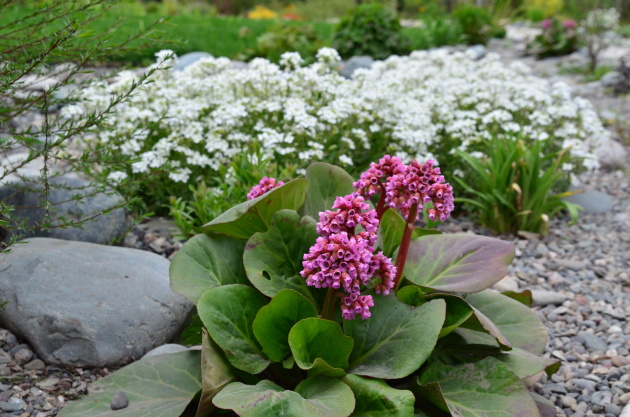

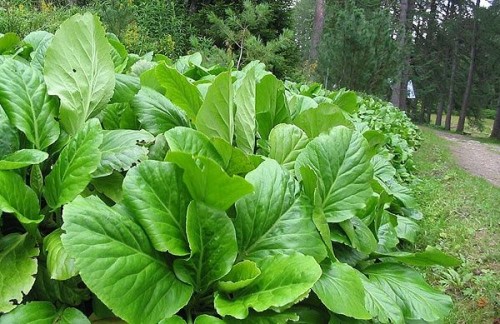
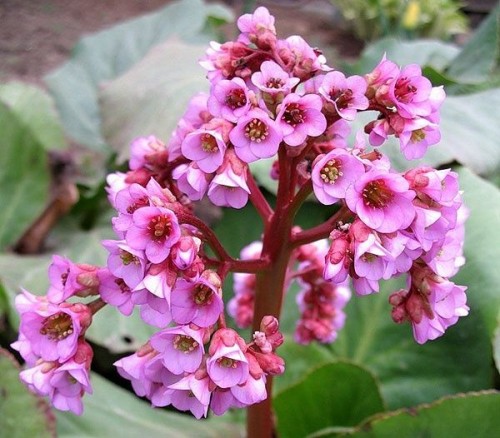
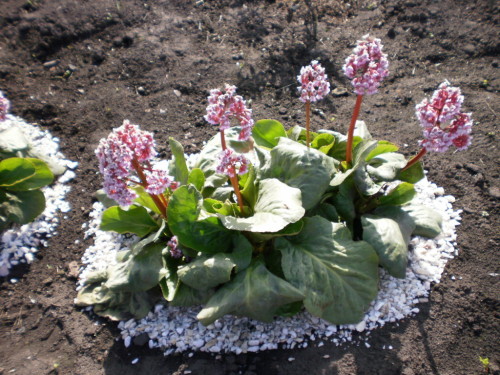
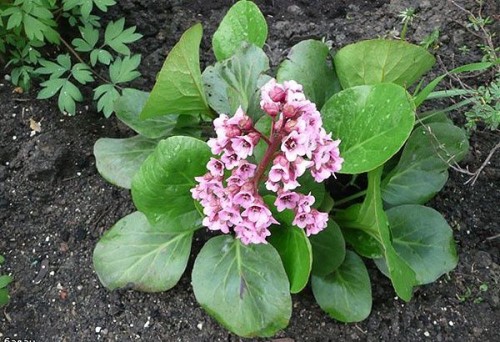
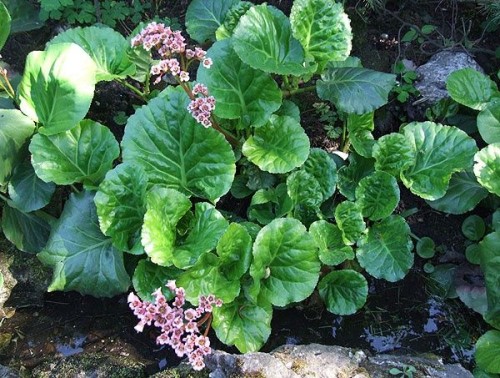
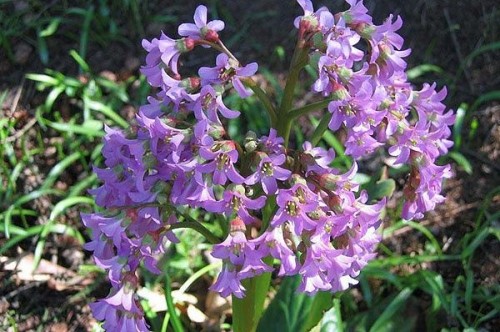
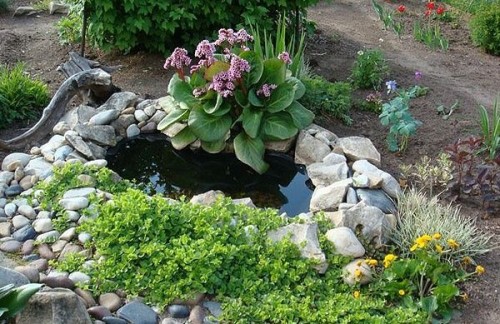
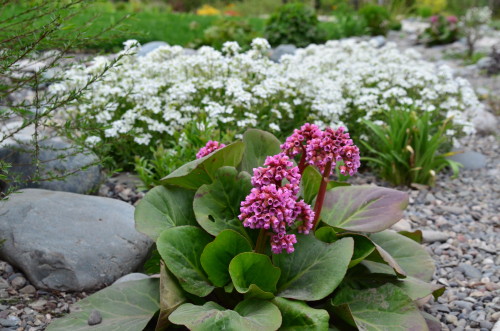
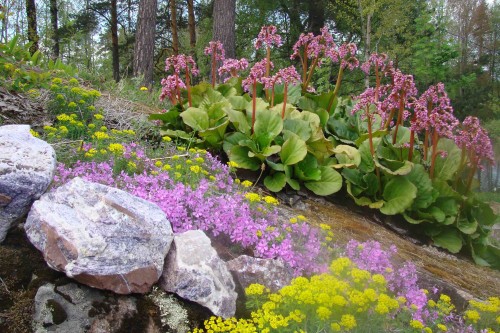
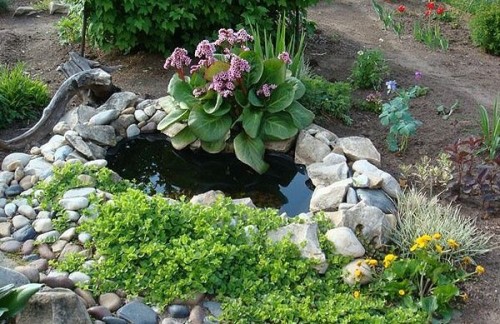












 Start a discussion ...
Start a discussion ...